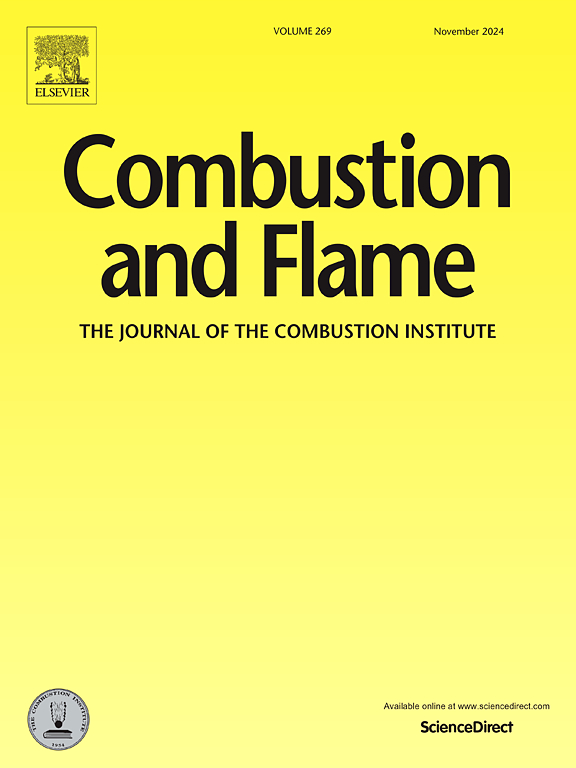Boundary layer flashback of H2/Air premixed flames in a swirling flow around a central body
IF 5.8
2区 工程技术
Q2 ENERGY & FUELS
引用次数: 0
Abstract
Fast and thin premixed hydrogen flames can lead to flashback scenarios which are unusual, especially for swirled configurations. Flashback can occur far from all walls, in the bulk flow, if the flow speed is less than the flame speed: this is a scenario which is usually avoided by increasing flow rates. However, flashback can also occur near walls where the flow speed goes to zero. Injector walls boundary layers always contain a zone where the local flow speed is less than the flame speed, even if the bulk flow velocity is large. The size of this zone is controlled by the velocity gradient at the wall which is the classical parameter used to predict flashbacks in boundary layers.
In this study, flashback of lean hydrogen–air flames is computed using DNS (Direct Numerical Simulation)(flame resolved). Without swirl, results are compared and validated against experimental measurements and usual flashback criteria based on wall velocity gradient. DNS are also performed with swirl in a sector of an annular chamber, providing maps of flashback occurrence as function of swirl number and wall velocity gradient. Results show that swirl enhances flashback propensity and that thermodiffusive effects must be accounted to build a flashback criteria, indeed very lean H flames flashback for flow speeds higher than expected.
Novelty and significance
Almost all injection systems designed for hydrogen face a new, key issue in terms of operability: flashback. This study presents for the first time an analysis of the combined effects on flashback of the velocity gradients at the wall and of swirl. DNS of a swirling flow around a central body are performed and flashback maps are produced in a (swirl-velocity gradient) diagram of direct use for systems injecting lean premixed hydrogen–air mixtures.
围绕中心体旋转流动的H2/Air预混火焰边界层闪回
快速而稀薄的预混氢火焰会导致不寻常的闪回场景,特别是对于旋涡结构。如果流动速度小于火焰速度,在远离所有壁的散装流动中,闪回可能发生:这种情况通常可以通过增加流量来避免。然而,倒叙也可能发生在流速为零的壁面附近。喷油器壁面边界层总是包含一个局部流动速度小于火焰速度的区域,即使整体流动速度很大。该区域的大小由壁面处的速度梯度控制,这是用于预测边界层闪回的经典参数。在本研究中,使用DNS(直接数值模拟)(火焰解析)计算贫氢-空气火焰的闪回。在没有涡流的情况下,将结果与实验测量结果和基于壁面速度梯度的通常闪回标准进行比较和验证。DNS还在环形腔室的一个扇区中使用涡流进行,提供了作为涡流数和壁速度梯度函数的闪回发生图。结果表明,涡流增强了闪回倾向,并且必须考虑热扩散效应来建立闪回标准,确实非常稀薄的H2火焰在流速高于预期的情况下闪回。几乎所有为氢气设计的喷射系统在可操作性方面都面临着一个新的关键问题:闪回。本文首次分析了壁面速度梯度和旋流对闪回的综合影响。对中心体周围的旋涡流进行了DNS分析,并在直接用于注入贫预混氢-空气混合物的系统的(旋涡速度梯度)图中生成了倒叙图。
本文章由计算机程序翻译,如有差异,请以英文原文为准。
求助全文
约1分钟内获得全文
求助全文
来源期刊

Combustion and Flame
工程技术-工程:化工
CiteScore
9.50
自引率
20.50%
发文量
631
审稿时长
3.8 months
期刊介绍:
The mission of the journal is to publish high quality work from experimental, theoretical, and computational investigations on the fundamentals of combustion phenomena and closely allied matters. While submissions in all pertinent areas are welcomed, past and recent focus of the journal has been on:
Development and validation of reaction kinetics, reduction of reaction mechanisms and modeling of combustion systems, including:
Conventional, alternative and surrogate fuels;
Pollutants;
Particulate and aerosol formation and abatement;
Heterogeneous processes.
Experimental, theoretical, and computational studies of laminar and turbulent combustion phenomena, including:
Premixed and non-premixed flames;
Ignition and extinction phenomena;
Flame propagation;
Flame structure;
Instabilities and swirl;
Flame spread;
Multi-phase reactants.
Advances in diagnostic and computational methods in combustion, including:
Measurement and simulation of scalar and vector properties;
Novel techniques;
State-of-the art applications.
Fundamental investigations of combustion technologies and systems, including:
Internal combustion engines;
Gas turbines;
Small- and large-scale stationary combustion and power generation;
Catalytic combustion;
Combustion synthesis;
Combustion under extreme conditions;
New concepts.
 求助内容:
求助内容: 应助结果提醒方式:
应助结果提醒方式:


